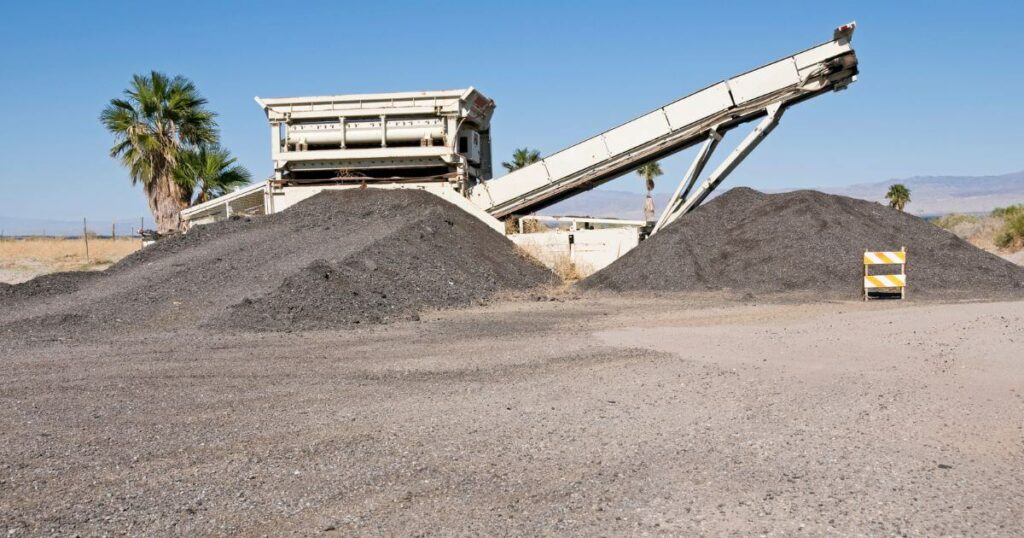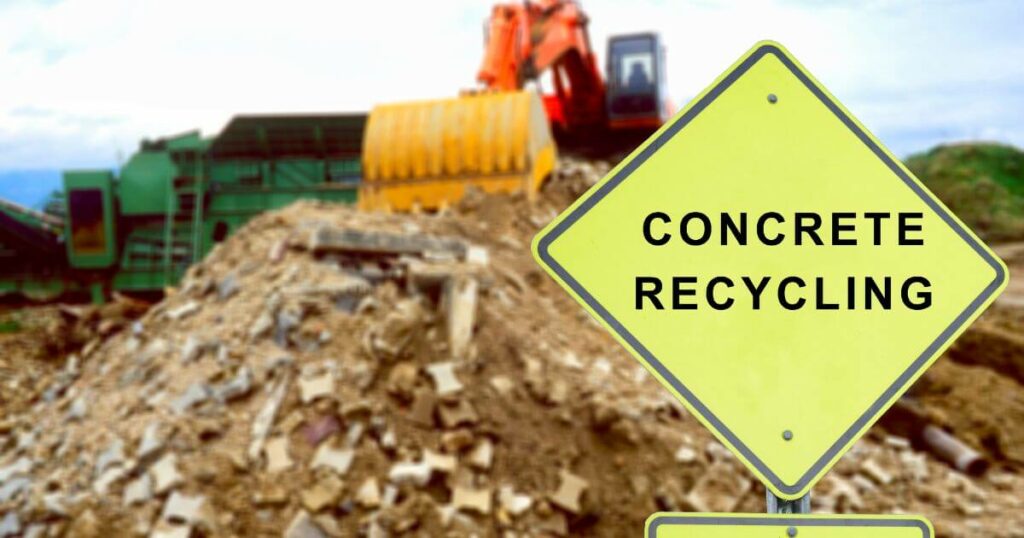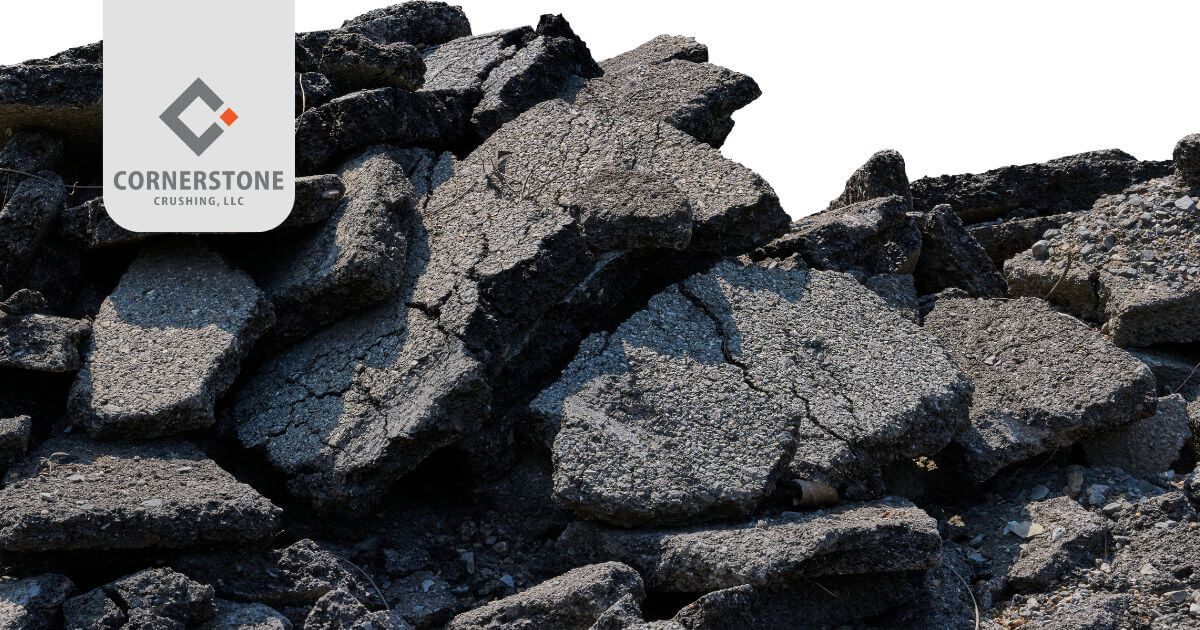In the ever-evolving world of construction, the concept of sustainability has taken center stage. As the demand for eco-friendly practices grows, the industry has embraced innovative solutions to reduce its environmental impact. Among these solutions, asphalt and concrete recycling has emerged as a game-changer, revolutionizing the way we approach construction projects. In this article, we will explore the significance of recycling these materials, the processes involved, and the benefits they offer to both the environment and the economy. Cornerstone Crushing, a material recycling company that specializes in concrete, asphalt, and topsoil recycling, plays a pivotal role in this sustainable movement, demonstrating how businesses can contribute significantly to eco-friendly construction practices.
Recycling Asphalt and Concrete: The Rise of Sustainable Construction Practices
The construction industry has long been known for its significant environmental footprint, with the production and disposal of materials contributing to greenhouse gas emissions, landfill waste, and the depletion of natural resources. However, the rise of sustainable construction practices has prompted a shift in mindset, with asphalt and concrete recycling at the forefront of this change. By embracing these recycling methods, the industry is not only reducing its environmental impact but also unlocking a host of economic benefits.
Traditional Disposal Methods
Traditionally, when asphalt and concrete reached the end of their useful life, they were simply demolished and hauled away to landfills. This approach not only contributed to the growing problem of landfill waste but also had significant environmental and economic consequences. The transportation of these materials to landfills resulted in increased greenhouse gas emissions, while the disposal process itself took up valuable landfill space. Moreover, the constant need for new raw materials put a strain on natural resources, leading to increased costs and environmental degradation.
The Rise of Asphalt and Concrete Recycling
Recognizing the unsustainable nature of traditional disposal methods, the construction industry began to explore alternative solutions. The concept of recycling asphalt and concrete gained traction, driven by a combination of factors, including:
- Growing environmental awareness and the need for sustainable practices
- Advancements in recycling technologies and processes
- Government regulations and incentives promoting recycling
- Economic benefits of using recycled materials
As a result, asphalt and concrete recycling have become increasingly popular, with a significant portion of these materials now being diverted from landfills and repurposed in new construction projects.
Environmental Concerns and Sustainability
The primary driver behind the adoption of asphalt and concrete recycling is the growing concern for the environment. The construction industry has recognized its responsibility to minimize its ecological footprint and contribute to a more sustainable future. By recycling these materials, the industry can:
- Reduce the amount of waste sent to landfills
- Conserve natural resources by reducing the need for virgin materials
- Lower greenhouse gas emissions associated with the production and transportation of new materials
Technological Advancements in Recycling
Advancements in recycling technologies have played a crucial role in the widespread adoption of asphalt and concrete recycling. Innovative machinery and processes have made it possible to efficiently break down, sort, and repurpose these materials, ensuring their quality and suitability for use in new construction projects. Some of the notable technological advancements include:
- Improved crushing and screening equipment
- Advanced contaminant removal systems
- Efficient material separation techniques
These advancements have not only streamlined the recycling process but have also improved the quality of the recycled materials, making them a viable alternative to virgin materials.
Government Initiatives and Regulations
Governments and regulatory bodies have also played a significant role in promoting asphalt and concrete recycling. Many countries have implemented policies and regulations that encourage or mandate the use of recycled materials in construction projects. These initiatives include:
- Tax incentives for using recycled materials
- Mandatory recycling targets for construction and demolition waste
- Green building certification programs that reward the use of recycled materials
These government-led efforts have created a supportive environment for the adoption of recycling practices, driving the industry towards a more sustainable future.

Asphalt Recycling
Asphalt recycling has become a cornerstone of sustainable road construction, with the majority of asphalt pavement now being recycled in many countries. The process involves reclaiming and reprocessing old asphalt pavement to create new, high-quality asphalt mixes.
Reclaimed Asphalt Pavement (RAP)
Reclaimed Asphalt Pavement (RAP) is the term used to describe the material obtained from the removal of old asphalt pavement. This material consists of aggregate coated with aged asphalt cement and is generated during the reconstruction, resurfacing, or utility work on asphalt roads, parking lots, and other paved surfaces.
RAP has become a valuable commodity in the construction industry, as it can be used as a partial substitute for virgin aggregate and asphalt binder in new asphalt mixes. The use of RAP not only reduces the need for new materials but also helps to conserve natural resources and minimize waste.
Asphalt Recycling Process
The asphalt recycling process typically involves the following steps:
- Asphalt Milling and Pulverization: The existing asphalt pavement is milled or pulverized to break it down into smaller, more manageable pieces. Milling involves the removal of the top layer of asphalt, while pulverization grinds up the entire pavement structure, including the base layer.
- Asphalt Screening and Sizing: The milled or pulverized asphalt is then screened and sized to ensure that the material meets the required specifications for use in new asphalt mixes. This process involves separating the RAP into different sizes and removing any contaminants, such as metal or debris.
- Incorporation into New Asphalt Mixes: The processed RAP is then incorporated into new asphalt mixes, either as a partial substitute for virgin aggregate and binder or as a complete replacement. The percentage of RAP used in the mix depends on factors such as the quality of the RAP, the intended use of the new pavement, and local regulations.
Recycled Asphalt Products and Applications
Recycled asphalt can be used in a wide range of applications, including:
- Hot Mix Asphalt (HMA) for road construction and resurfacing
- Cold Mix Asphalt (CMA) for pavement repairs and maintenance
- Asphalt Shingles for roofing applications
- Asphalt Pavers for landscaping and architectural projects
The use of recycled asphalt in these applications offers numerous benefits, such as reduced material costs, improved pavement performance, and a lower environmental impact compared to the use of virgin materials.

Concrete Recycling
Concrete recycling has also gained significant traction in the construction industry, as it offers a sustainable solution for managing the vast amounts of concrete waste generated during demolition and renovation projects.
Concrete Demolition and Removal
The concrete recycling process begins with the demolition and removal of existing concrete structures, such as buildings, bridges, and pavements. Specialized equipment, such as hydraulic excavators with concrete crushers, is used to break down the concrete into smaller pieces, making it easier to transport and process.
On-site and Off-site Concrete Crushing
Once the concrete has been demolished and removed, it is crushed to create recycled concrete aggregate (RCA). This process can be performed either on-site using mobile crushing equipment or off-site at a dedicated recycling facility.
On-site crushing offers the advantage of reducing transportation costs and emissions, as the recycled material can be used directly in the new construction project. Off-site crushing, on the other hand, allows for more advanced processing and quality control measures, ensuring that the RCA meets the required specifications for various applications.
Recycled Concrete Aggregate (RCA)
Recycled Concrete Aggregate (RCA) is the product obtained from the crushing and processing of old concrete. RCA consists of high-quality, well-graded aggregates that can be used as a substitute for virgin aggregates in a variety of construction applications, such as:
- Road base and sub-base layers
- Structural fill and embankments
- Drainage layers and erosion control
- New concrete mixes (as a partial substitute for virgin aggregate)
The use of RCA in these applications helps to conserve natural resources, reduce waste, and lower the environmental impact of construction projects.
Environmental and Economic Benefits
The adoption of asphalt and concrete recycling offers a multitude of environmental and economic benefits, making it an attractive option for the construction industry.
Reduced Waste and Landfill Usage
By recycling asphalt and concrete, the construction industry can significantly reduce the amount of waste sent to landfills. This not only helps to conserve valuable landfill space but also minimizes the environmental impact associated with the disposal of these materials.
Conservation of Natural Resources
Recycling asphalt and concrete reduces the need for virgin materials, such as aggregate and asphalt binder, which are obtained from natural resources. By using recycled materials, the industry can help to conserve these resources, ensuring their availability for future generations.
Cost Savings for Construction Projects
The use of recycled asphalt and concrete can lead to substantial cost savings for construction projects. Recycled materials are often cheaper than virgin materials, as they require less processing and transportation. Additionally, the use of recycled materials can help to reduce disposal costs associated with the removal of old asphalt and concrete.
Reduced Greenhouse Gas Emissions
Asphalt and concrete recycling can significantly reduce greenhouse gas emissions associated with the production and transportation of construction materials. By using recycled materials, the industry can minimize the energy consumption and emissions related to the extraction, processing, and transportation of virgin materials.
| Benefits of Asphalt and Concrete Recycling | Environmental | Economic |
| Reduced waste and landfill usage | ✓ | |
| Conservation of natural resources | ✓ | |
| Cost savings for construction projects | ✓ | |
| Reduced greenhouse gas emissions | ✓ |
Challenges and Limitations
While asphalt and concrete recycling offer numerous benefits, there are some challenges and limitations that the industry must address to ensure the successful implementation of these practices.
Quality Control and Contaminants
One of the main challenges in recycling asphalt and concrete is ensuring the quality of the recycled materials. Contaminants, such as soil, clay, and other debris, can affect the performance of the recycled materials in new applications. To overcome this challenge, strict quality control measures must be in place, including thorough inspection and testing of the recycled materials.
Gradation and Abrasion Differences Compared to Virgin Materials
Recycled asphalt and concrete may have different gradation and abrasion characteristics compared to virgin materials. These differences can impact the performance of the recycled materials in certain applications. To address this issue, the industry must develop and adopt best practices for the use of recycled materials, ensuring that they meet the required specifications for each application.
Future Trends and Opportunities
As the construction industry continues to embrace sustainability, the adoption of asphalt and concrete recycling is expected to grow. Some of the future trends and opportunities in this field include:
Increasing Adoption of Recycled Materials
The use of recycled asphalt and concrete is likely to become more widespread as the industry recognizes the environmental and economic benefits of these practices. This trend will be driven by a combination of factors, including government regulations, corporate sustainability goals, and growing public awareness of environmental issues.
Legislative Pressure and Mandates Promoting Recycling
Governments and regulatory bodies are expected to play an increasingly important role in promoting asphalt and concrete recycling. This may include the introduction of new regulations and mandates that require the use of recycled materials in construction projects, as well as incentives for companies that adopt sustainable practices.
Potential for 100% Recycled Asphalt and Concrete Products
As recycling technologies and processes continue to advance, the potential for producing 100% recycled asphalt and concrete products becomes more realistic. This would represent a significant milestone in the industry’s efforts to reduce its environmental impact and promote a circular economy.
Trust Cornerstone Crushing for Sustainable Concrete and Asphalt Practices
The rise of asphalt and concrete recycling represents a significant shift in the construction industry’s approach to sustainability. By embracing these practices, the industry can reduce waste, conserve natural resources, lower greenhouse gas emissions, and achieve substantial cost savings. As the demand for sustainable construction practices continues to grow, asphalt and concrete recycling will play an increasingly important role in shaping the future of the industry.
To fully realize the potential of these practices, it is essential for construction professionals, policymakers, and the public to work together to promote the adoption of recycling technologies and best practices. By doing so, we can build a more sustainable future for the construction industry and the environment as a whole.
Frequently Asked Questions (FAQ)
What is the difference between asphalt and concrete recycling?
Asphalt recycling involves reclaiming and reprocessing old asphalt pavement to create new asphalt mixes, while concrete recycling involves crushing and processing old concrete to create recycled concrete aggregate (RCA) for use in various construction applications.
How does recycling asphalt and concrete benefit the environment?
Recycling asphalt and concrete benefits the environment by reducing waste, conserving natural resources, and lowering greenhouse gas emissions associated with the production and transportation of virgin materials.
Is the quality of recycled asphalt and concrete comparable to virgin materials?
With proper quality control measures and adherence to industry standards, recycled asphalt and concrete can offer performance comparable to virgin materials in many applications. However, it is essential to ensure that the recycled materials meet the required specifications for each specific use.
What are the cost benefits of using recycled asphalt and concrete in construction projects?
Using recycled asphalt and concrete in construction projects can lead to significant cost savings, as these materials are often cheaper than virgin materials. Additionally, the use of recycled materials can help to reduce disposal costs associated with the removal of old asphalt and concrete.
How can I incorporate recycled asphalt and concrete into my construction projects?
To incorporate recycled asphalt and concrete into your construction projects, start by familiarizing yourself with the available recycled materials and their suitable applications. Work with experienced suppliers and contractors who specialize in the use of recycled materials, and ensure that the materials meet the required specifications for your project. Consider seeking guidance from industry associations and sustainability experts to help you navigate the process of adopting recycled materials in your projects.
Embrace the sustainable revolution in construction by contacting Cornerstone Crushing for your asphalt and concrete recycling needs. Our expert team is dedicated to providing eco-friendly and cost-effective solutions for your projects. Join the movement towards a greener future and experience the benefits of recycled materials firsthand. Contact us today to learn more!


